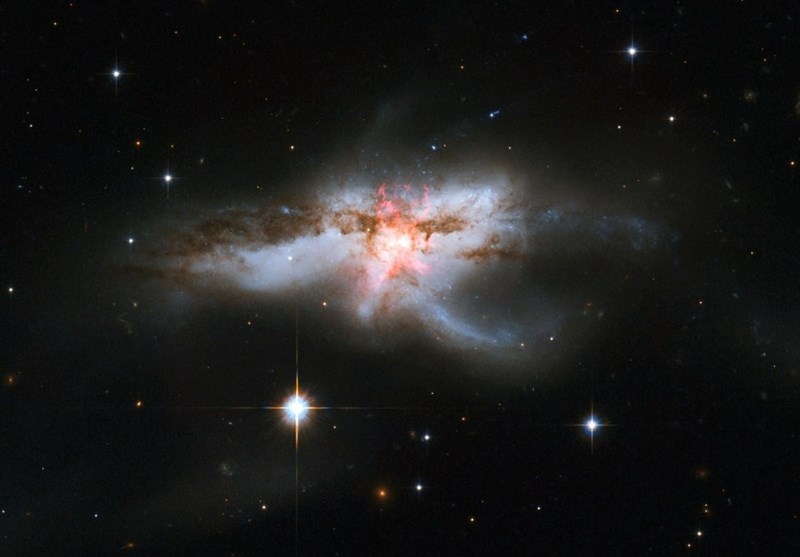Astronomers Puzzled by Milky Way-Like Galaxy Found in Deep Space
TEHRAN (Tasnim) – Twelve billion years ago, when all of space was just a fledgling baby universe, a young galaxy reminiscent of the Milky Way was flaring to life deep in the cosmos.
Astronomers have often thought of this early universe as a chaotic, extreme environment where galaxies are unstable and violent.
New research suggests those assumptions may be incorrect, providing new insight into how galaxies form.
In a new study, published in the journal Nature on Wednesday, observations made by Chile's Atacama Large Millimeter/submillimeter Array (ALMA) of SPT–S J041839–4751.9, or SPT0418-47 for short, show the infant galaxy has features similar to those of our own more mature Milky Way. Light from the galaxy took 12 billion years to reach us. That means astronomers are looking back in time at a galaxy that formed less than 1.5 billion years after the birth of the universe.
Previous modeling and observations have led astronomers to theorize that the period after the universe's birth was tumultuous. Early galaxies were likely smashing into each other and merging to form big, disordered masses of stars. They shouldn't settle down into neat, flat disks. But SPT0418-47 does, and that's quite a surprise that upends some of our beliefs about early cosmic activities in the universe.
"This result represents a breakthrough in the field of galaxy formation, showing that the structures that we observe in nearby spiral galaxies and in our Milky Way were already in place 12 billion years ago," Francesca Rizzo, an astronomy Ph.D. student at Germany's Max Planck Institute for Astrophysics and first author on the study, said in a statement.
Because SPT0418-47 is so far away, it's difficult to locate in the sky because its light is so faint. To find and characterize SPT0418-47, the research team took advantage of a phenomenon known as "gravitational lensing." Light from distant galaxies does not travel on a straight line to Earth -- it's influenced by the effects of gravity on its way here. Nearby galaxies distort and reshape the light from more distant galaxies as it travels to our telescopes.
But lensing can aid detection. Using the technique and the ALMA telescope, researchers were able to magnify the light from SPT0418-47 and boost the resolution to observe the young galaxy's features. The effect of the lensing means images obtained by ALMA shows SPT0418-47 as an aggressive, fiery Eye of Sauron-type ring, a perfect circle of light containing hundreds of thousands of stars.
Using computer modeling techniques, the research team took the gravitationally lensed, circular images of SPT0418-47 and reconstructed what the galaxy would look like if our telescopes were powerful enough to see that far on their own (as the video below demonstrates). The modeling reshaped the galaxy in a surprising way.
"When I first saw the reconstructed image of SPT0418-47 I could not believe it," Rizzo said. "A treasure chest was opening."
The reconstruction showed SPT0418-47 doesn't quite have the large, spiral arms we're used to seeing in the Milky Way, but it does have a disc and a giant bulge at its center, reminiscent of our home galaxy. The European Southern Observatory suggest it's a Milky Way lookalike.
"It's less of a lookalike and more of a mini-me," says Sarah Martell, an astrophysicist at the University of New South Wales who was not affiliated with the study. "It's only 25% of the mass of the Milky Way and half the size."
But what it lacks in stature it makes up for in star power. The galaxy's star formation rate is equivalent to the mass of 350 of our own suns, which Martell calls "enormous." By comparison, she notes, the Milky Way's star formation rate is just 1.6 solar masses per year. Simona Vegetti notes the star formation rate is "quite puzzling," because it signifies the galaxy as a site of highly energetic processes. Presumably, this would lead to more disorder, but SPT0418-47 remains cool and calm even with all of that activity.
The young galaxy won't evolve into a Milky Way-type spiral galaxy like those we're familiar with today. Instead, the researchers believe it will become an elliptical galaxy like Messier 87, where the first images of a black hole were captured. Such a fate won't occur for millions of years. However, when the European Southern Observatory's Extremely Large Telescope comes online in 2025, it's likely astronomers will find more of these ordered galaxies, allowing them to uncover how they might form and evolve in the early universe.






